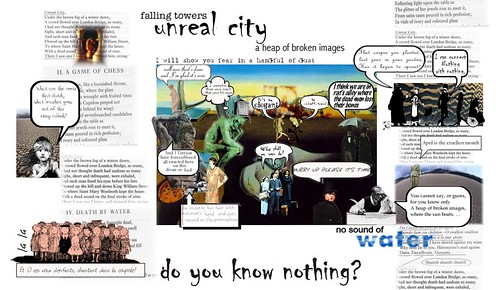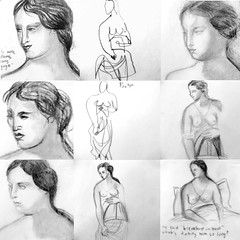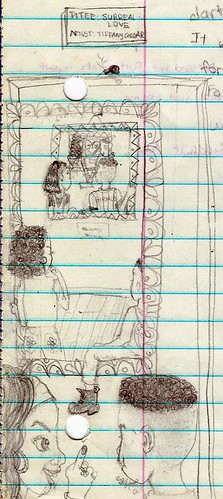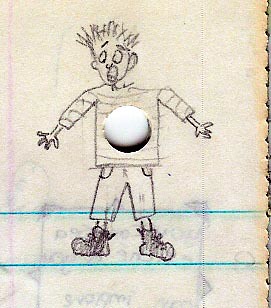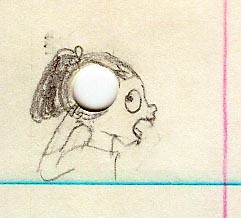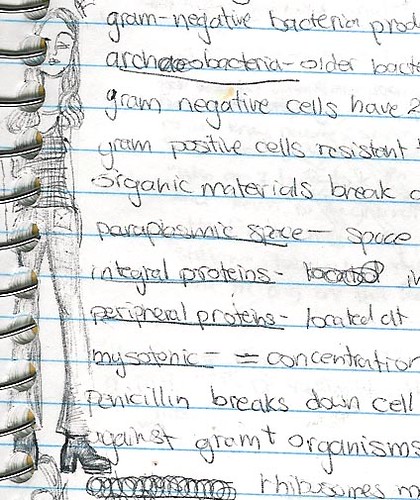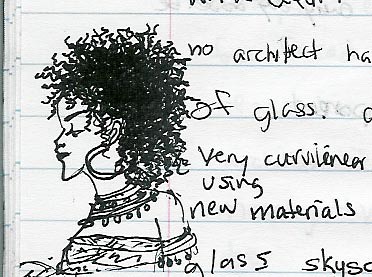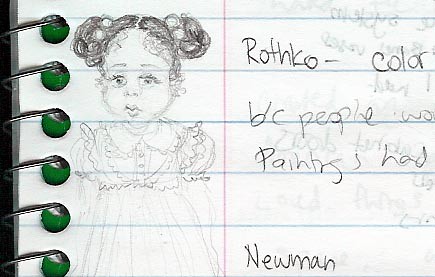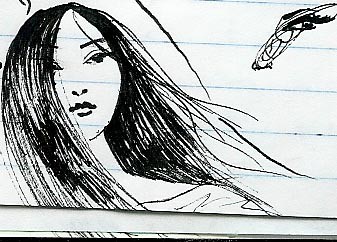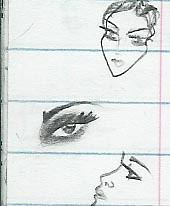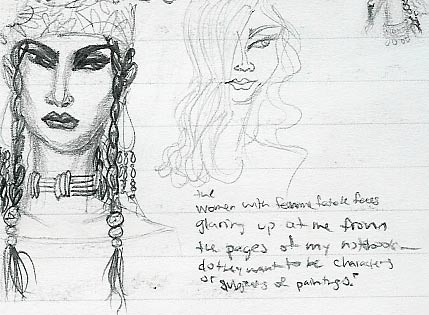Monday, December 2, 2019
Mood Board Monday: a loft in earth tones and shades of green
Here's the final rendering of the space, created with a combination of hand-drawn, hand-painted, and digital elements:
Most of the art is by Nelson de la Nuez and Rex Ray.
Monday, November 11, 2019
Mood Board Monday: an art deco condo
Monday, September 16, 2019
Mood Board Monday: a retro breakfast nook
Friday, July 27, 2012
My new book is now on Blurb!
I just published my first book about my art! Okay, so technically this is not my first art book. The very first one I created dates back to 1986, Tiffany's Art Catalog.
 |
As you can see from the cover, my preferred medium at the time was fine point felt-tip markers. Since then, I have written mostly fiction. I even went to grad school to study fiction writing, though I dropped out after succumbing to a severe case of writer's block.
But my new book, Post-Consumerism, is not a work of fiction. Nor is it just a catalog of art. In addition to featuring large color photos of my work, my book also tells the story of how I decided to become an artist and what inspired me. Drawing from my thesis paper, my blog posts, and old journal entries, it offers an autobiographical account of my life as an artist from 2007 until 2010. It is 58 pages long.
I wanted to produce an art book because I thought it would be something that people who like my art would like to purchase. It costs less than all my original paintings except for the minis, and features all the paintings I made from 2007-2010 that were included in my solo show, as well as a few that weren't. I tried to price it in a range that is pretty close to what museum shops and bookstores charge for their art books, while still making a profit. of $5 per copy.
I decided to self-publish this book because I already know from past experiece how hard it is to find a literary agent, get a publisher, and wait for the book to be published. It takes too long and there are too many gatekeepers in the way, and I've had enough of that. So this book, like my art career, was a DIY project. Over the past few years, I wrote it, took all the pictures, and did the layout myself. I did have it professionally edited by a good friend who majored in English and used to work for an encyclopedia company. In exchange for my friend's expertise, I created a custom painting for her.
I plan to put out a series of art books every few years and have already started on the next one. I also plan to write a book about The Doll Project when it's complete. Hopefully this venture will be a success and all the time and effort I've put into this book will be worth it.
Here is a preview of the book:
Post-Consumerism is available in softcover, hardcover, and iPad ebook formats. The ebook is $6.99, the softcover edition is $34, and the hardcover edition is $43. I will have a few copies for sale at my next open studio(/book signing) but if you can't wait or can't make it, order yours today. Save 20% when you purchase a copy before August 5th and enter the following coupon code at checkout: RMN20OFF.
When you get your hard copy, bring it to an open studio and I will sign it for you. :)
Wednesday, June 10, 2009
Widget Wednesday: Our Story

If you have ever needed to create a timeline and wanted to use pictures to illustrate it, OurStory is a great widget to create one. You can do it on your own, or collaborate with other contributors. You can share it on a blog, a social networking site, or your own webpage. Or if it's too personal to share with the world, you can set it to private. It's perfect for weddings and baby pictures, or to document your progress as an artist. I am using it to create a timeline of the work I did before I graduated from college, which you may know as the From the Archives series. If you'd like to see my timeline, click here. And if you decide to create one of your own and want to share it, comment on this post and put a link in your comment.
Wednesday, April 1, 2009
The Waste Land Montage [from the archives]
April is the cruellest month, breeding
Lilacs out of the dead land, mixing
Memory and desire, stirring
Dull roots with spring rain.
--T.S. Eliot, "The Waste Land"
In my “Waste Land” montage, I decided to display images with the text because I felt that the two complement and supplement one another. When I began developing the concept of the montage, one of the first things that I thought of was the fragmentation of the poem. I decided that the picture should visually represent the fragmentation, which is why I didn’t blend various images together as I did in a few of the other montages. Instead, I selected a menagerie of images, from paintings, to sculptures, to photographs and prints. I use Salvador Dali’s “The Persistence of Memory” as a background because I felt that the surrealist painting portrays many of Eliot’s themes. Like “The Waste Land,” it gives the viewer a sense of barrenness and desolation. I also use desert landscapes because they are representative of the poem’s recurrent imagery.
The people I chose represent the diverse array of speakers in the poem. Many are familiar images, such as the couple with the umbrella from a Gustave Caillebotte painting, Rodin’s “The Thinker,” and the woodcut of Cosette from Les Miserables. The people are representative of Eliot’s contemporaries and predecessors, as well as their characters. To show that the poem is told from multiple viewpoints, I gave each one a different speech balloon and quote from the poem.
Click to see the larger image.

Sunday, March 1, 2009
Traffic In Women Collage, 1998 [from the archives]
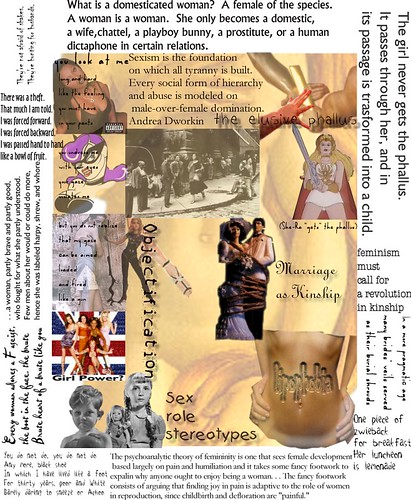
"Traffic in Women Collage" digital montage 1998
I have chosen this piece since March is Women's History Month. My first introduction to feminist theories and texts was in college. Before then, I had only known about the movement for gender equality from history classes, but had never read from its primary sources. In my freshman year humanities class, we read Gayle Rubin's "The Traffic in Women: Notes on the 'Political Economy' of Sex," as well as the poetry that is quoted in the picture. (I also included a short poem of my own.) This montage was an effort to make sense of it all.
And this is what I wrote about it:
My montage brings out the recurring themes of the feminist poetry and prose that we read near the end of the quarter. At the very top is a quote from Andrea Dworkin which states that “sexism is the foundation on which all tyranny is built. Every social from of hierarchy and abuse is modeled on male-over-female domination.” I found this quotation particularly relevant to the piece because an outcry against sexism is what these texts are built upon. Rubin’s essay addressed the idea of penis envy in a fresh and memorable way. On page 195, she says,
The girl never gets the phallus. It passes through her, and in its passage is transformed into a child. When she “recognizes her castration,” she acceded to the place of a woman in a phallic exchange network. She can “get” the phallus--in intercourse, or as a child--but only as a gift from a man. She never gets to give it away.
With this in mind, I decided that it was a very important part of the essay, one definitely worth of visual interpretation. But how? As I read over the essay for the second time, I realized that the phallus as she describes it is a “symbolic token,” (Rubin, 194) “the set of meanings conferred upon the penis.” (190) I learned from studying the ideas of Freud and others of the psychoanalytic school that phallic symbols are ubiquitous in our society, whether in the form of skyscrapers, telephone poles, or even cigars. The image I finally selected for this is that of a golden baton being passed on from one male relay racer to another, the baton being the phallus. And superimposed upon them is the outstretched hand of an infant, reaching for the phallus yet not obtaining it. This symbolizes the Freudian Oedipal struggle of infancy. Beneath this I placed a picture of a female superhero who, although objectified in her skimpy costume, has obtained the phallus in the form of a sword.
Objectification is a recurring theme in the feminist poetry and prose, particularly in “The Venus Hottentot” and also in “The True Bride,” where the speaker describes his “ideal pornography”--an army of hobbling invalid women “hunting for husbands.” (601) Objectification, the portrayal of women as sex objects, strips women of their humanity. Sadly, I found far too many visual examples of this. In the objectification portion of my collage, I use images that come from four different media: music, the internet, fashion, and the movie industry. Also included in this section is a poem that I wrote about being perceived as an object.
Marriage is almost always portrayed in these texts in a negative light, so I selected the image of bride and groom dolls bound together with twine. Also included, though not as greatly emphasized, are sex role expectations and stereotypes. The stiff, unsmiling girl who seems displeased with her look-alike doll is an image of passivity while the pugnacious little boy in boxing gloves is an image of aggression.

Sunday, February 8, 2009
Native Son Montage, 1997 [from the Archives]
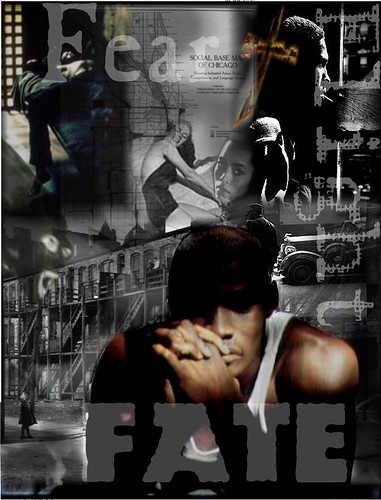
"Native Son Montage" digital montage 11"x14" 1997
My Native Son montage depicts Bigger’s final contemplation of himself and his life. Up until the very end of the book, Bigger has no inner life. Like Fanon’s native, because he lacks an inner life, Bigger “does not commit suicide. He kills.” But there are a few fleeting introspective moments when, twenty years old and about to die, he begins piecing together elements of his life. This state of mind is portrayed in the montage by the shadowed face of the man in the foreground.
Etiological elements of Bigger’s development are pictured in the background, including a photograph of run-down depression-era Chicago tenement houses. At the top center of the picture is a Great Migration era “Social Base Map of Chicago,” which shows the racial makeup of neighborhoods around Chicago. This represents the extreme segregation of the so-called “City of Neighborhoods,” which resulted in the “locked-in life of the Black belt areas” that Wright describes in “How ‘Bigger’ Was Born.”
The images I selected of Mary and Bessie portray them both as living. At first I considered using pictures of them as corpses, primarily because of Bigger’s responsibility for their deaths. Yet I realized that Bigger spends little time at the end of the novel contemplating their murders. He is no longer haunted by the image of the severed head or the bludgeoned body. This was why I chose pictures representative of the two young women’s personalitiesMary carefree and smiling in a scene reminiscent of her newsreel portrayal, and Bessie looking downtrodden and miserable. To the left of Bessie and Mary is an image representative of Bigger’s job as a chauffeur. Above it, Bigger looks out of a broken window in an abandoned building as he hides from the law. The personage in blackface sweeping down upon him like the wailing ghosts of Picasso’s “Guernica” symbolizes the pervasive racism of the time. The burning cross at the top embodies Bigger’s struggle with racial hatred and his own hatred of Christianity and its cross. Lastly, the words “Fear,” “Flight,” and “Fate” are strategically placed in the montage. With his fear and flight behind him, the only thing that Bigger has ahead of him is his fate.

Sunday, February 1, 2009
Venus Hottentot Montage, 1997 [from the archives]
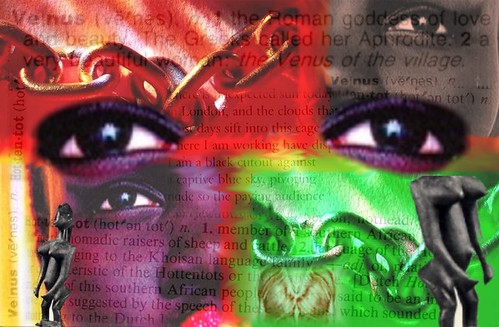
"Venus Hottentot Montage" Digital Montage 11"x14" 1997
Since February is Black History Month, I will be featuring pieces from my archives that relate to that theme.
Copyright © Elizabeth Alexander, from The Venus Hottentot, Graywolf Press, 2004
The Venus Hottentot
(1825)
1. Cuvier
Science, science, science!
Everything is beautiful
blown up beneath my glass.
Colors dazzle insect wings.
A drop of water swirls
like marble. Ordinary
crumbs become stalactites
set in perfect angles
of geometry I’d thought
impossible. Few will
ever see what I see
through this microscope..
Cranial measurements
crowd my notebook pages,
and I am moving close,
close to how these numbers
signify aspects of
national character.
Her genitalia
will float inside a labeled
pickling jar in the Musee
de l’Homme on a shelf
above Broca’s brain:
“The Venus Hottentot.”
Elegant facts await me.
Small things in this world are mine.
2.
There is unexpected sun today
in London, and the clouds that
most days sift into this cage
where I am working have dispersed.
I am a black cutout against
a captive blue sky, pivoting
nude so the paying audience
can view my naked buttocks.
I am called “Venus Hottentot.”
I left Capetown with a promise
of revenue: half the profits
and my passage home: a boon!
Master’s brother proposed the trip;
the magistrate granted me leave.
I would return to my family
a duchess, with watered-silk
dresses and money to grow food,
rouge and powder in glass pots,
silver scissors, a lorgnette,
voile and tulle instead of flax,
cerulean blue instead
of indigo. My bother would
devour sugar-studded nonpareils,
pale taffy, damask plums.
That was years ago. London’s
circuses are florid and filthy,
swarming with cabbage-smelling
citizens who stare and query,
“Is it muscle? Bone? Or fat?”
My neighbor to the left is
The Sapient Pig, “The Only
Scholar of His Race.” He plays
at cards, tells time and fortunes
by scraping his hooves. Behind
me is Prince Kar-mi, who arches
like a rubber tree and stares back
at the crowd from under the crook
of his knee. A professional
animal trainer shouts my cues.
There are singing mice here.
“The Ball of Duchess DuBarry”:
In the engraving I lurch
towards the belles dames, mad-eyed, and
they swoon. Men in capes and pince-nez
shield them. Tassels dance at my hips.
In this newspaper lithograph
my buttocks are shown swollen
and luminous as a planet.
Monsieur Cuvier investigates
between my legs, poking, prodding,
sure of his hypothesis.
I half expect him to pull silk
scarves from inside me, paper poppies,
then a rabbit! He complains
at my scent and does not think
I comprehend, but I speak
English. I speak Dutch. I speak
a little French as well, and
languages Monsieur Cuvier
will never know have names.
Now I am bitter and now
I am sick. I eat brown bread,
drink rancid brother. I miss good sun,
miss Mother’s sadza. My stomach
is frequently queasy from mutton
chops, pale potatoes, blood sausage.
I was certain that this would be
better than farm life. I am
the family entrepreneur!
But there are hours in every day
to conjure my imaginary
daughters, in banana skirts
and ostrich-feather fans.
Since my own genitals are public
I have made other parts private.
In my silence, I possess
mouth, larynx, brain, in a single
gesture. I rub my hair
with lanolin, and pose in profile
like a painted Nubian
archer, imagining gold leaf
woven through my hair, and diamonds.
Observe the wordless Odalisque.
I have not forgotten my Xhosa
clicks. My flexible tongue
and healthy mouth bewilder
this man with his rotting teeth.
If he were to let me rise up
from this table, I’d spirit
his knives and cut out his black heart,
seal it with science fluid inside
a bell jar, place it on a low
shelf in a white man’s museum
so the whole world could see
it was shriveled and hard,
geometric, deformed, unnatural.

Sunday, December 14, 2008
America for sale - cheap, 1989 [from the archives]
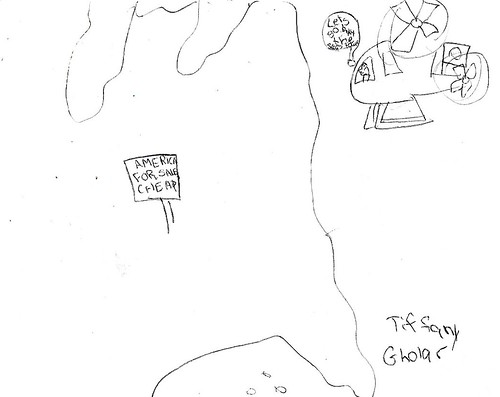
"America for sale - cheap" | 1989 | Ballpoint pen on paper
My first little piece of social commentary art. This is a sketchbook drawing I did when I was 10 years old. In case you can't read my wonderful handwriting, the helicopter pilot is saying, "Let's buy the Sears Tower" and the sign on the map of the US says "America for sale cheap."
I had overheard my parents discussing the sale of the Sears Tower. There was talk of a possible sale to foreign investors. Of course, now I realize I should have drawn the "for sale" sign on my home state of Illinois.

Sunday, November 30, 2008
From the Archives: A Bitter Pill to Swallow illustrations, 1996-2000
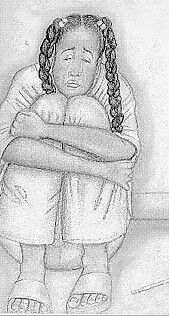
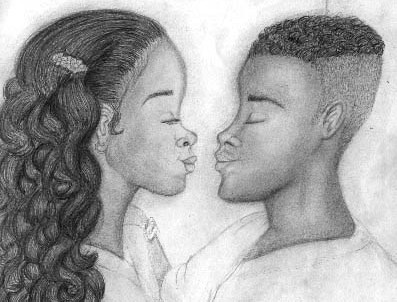
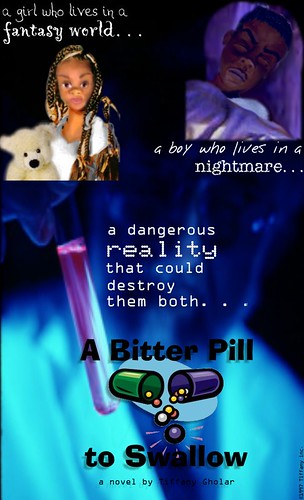
So. I experimented. And sometimes, experiments fail.
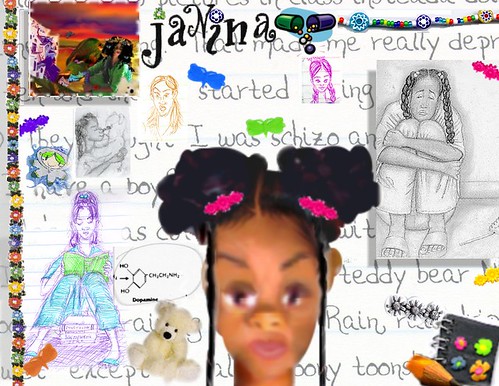
But I learned from my mistakes.
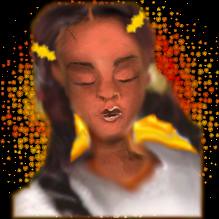 After taking a class in web design, I thought about creating a web site for my novel. I still have a few illustrations I designed for it:
After taking a class in web design, I thought about creating a web site for my novel. I still have a few illustrations I designed for it:
A Bitter Pill to Swallow is the story of two teenagers who meet under difficult circumstances.

After witnessing the drive-by shooting death of his friend Monica, 15 year old Devante develops post-traumatic stress disorder and attempts suicide.
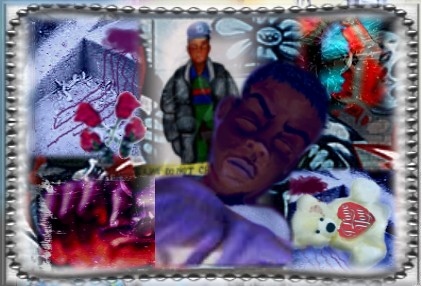
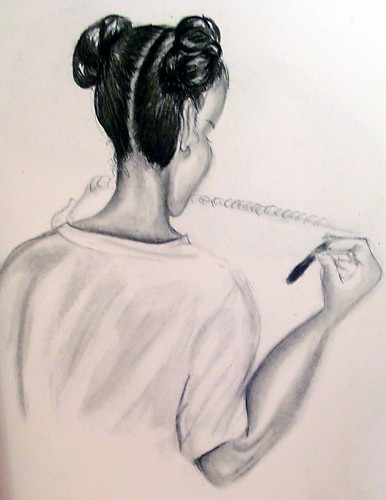
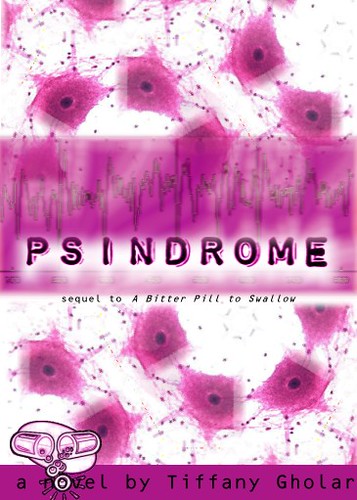
And there's also a weird little clip for a trailer I'd planned to make for it, designed in Kai's Power Goo:
If you're interested in reading excerpts from my novel, I'm sorry to say that I have no excerpts online right now. But I have posted two prequel short stories on my other blog. The first is entitled "A Little Fall of Rain" and the next one is called "A Reason to Die."
Tuesday, November 25, 2008
From the Archives: Raven's Song, Circa 1998
--Edgar Alan Poe
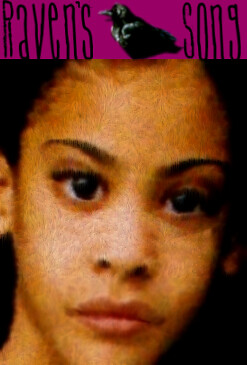
Before my unfinished novel Raven's Song begins, that quote from "The Cask of Amontillado" is the first thing you see. Raven’s Song is the story of Raven, a 15-year old girl who has been sent away to a boarding school by her parents in order to safely hide her away from her stalker ex-boyfriend Tiyon. Raven is miserable because she is interested in art and the school she has been sent to specializes in math and science. She also feels ashamed that she ever got involved with Tiyon, who had a long history of emotional problems. One day she discovers that Tiyon has sent her a letter at school. One of her friends had been tricked into giving him her new address. Now realizing her cover is blown but not wanting to transfer schools again, Raven decides to take things into her own hands. She will get revenge. She will stalk him. But will her obsession with getting revenge take over Raven’s life?
This novel has been abandoned since 2002, but you can read some excerpts from it over at my fiction blog, Tragedienne.
Thursday, November 20, 2008
From the Archives: My Island, New Paya
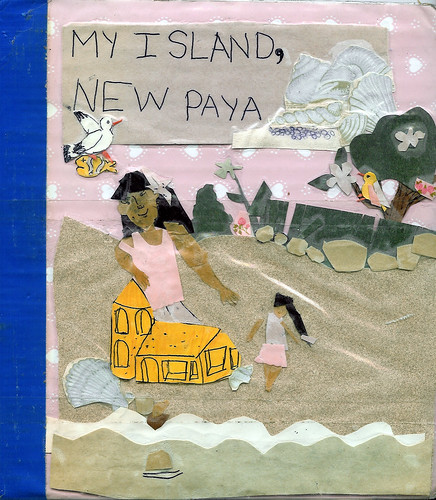
I've had a fascination with people getting shipwrecked on tropical islands almost as long as I can remember. I blame it on the animated version of Gilligan's Island that I used to watch on Saturday mornings. When I was 10, I began writing a series of stories about the adventures of Miriam, whose family was stranded on an island for 3 years on 2 different islands after their cruise ship exploded and sank in the middle of the ocean. Miriam was stranded on an island with her father. And incidentally, Miriam lives in the same parallel universe as Roxy. I named my character Miriam because as a little girl in Sunday School, I liked the Old Testament story of Miriam and Moses. Perhaps because I am an older sister of a younger brother I could relate to her. Somehow she manages to be a good big sister while still getting rid of her little brother. (Chris, if you're reading this, you know I'm just joking, right?)
By 1992, I had stopped writing about Miriam, but I decided to try out my new style of drawing by doing a few illustrations of her. So the result is the faint, insecure rendering drawn by the hands of a self-conscious 13 year old. It's an unfortunate phase many young artists go through. I was so afraid of making a mistake that I drew very lightly so I could erase it more easily. I had to enhance the contrast just to make it viewable on the computer.

Miriam saved the cute little baby bird in the picture, in addition to an orphaned fox. She and her father built a beautiful stone cottage with a thatched roof, which you can see in the background.

By 1999, I was in college and taking fiction writing classes. I returned to my old story and re-tooled it as a Young Adult novel entitled "My Island, Nueva Playa." (Not sure if the syntax of the Spanish in the title is correct.) Miriam was now Rima, a biracial 16 year old who did not want to be rescued from the island because she felt like it was the only place where she truly belonged. I stole the name Rima from a character in the novel Green Mansions. And I was still learning how to create digital illustrations on the computer. This one uses a girl from a Delia's catalog and a stock photo of an island. The novel is still unfinished, but you can read an excerpt from it over at my other blog, Tragedienne.
Watching Gilligan on Saturday mornings proved to be a source of inspiration for me. And the Gilligan's Island cartoon was the gateway drug that led to me watching the Gilligan's Island live-action series from the 60's, which led to repeated readings of Robinson Crusoe, Swiss Family Robinson, Island of the Blue Dolphins, and Lord of the Flies, and my current obsession with the TV series Lost.
Monday, November 10, 2008
From the Archives: "Roxy," circa 1991
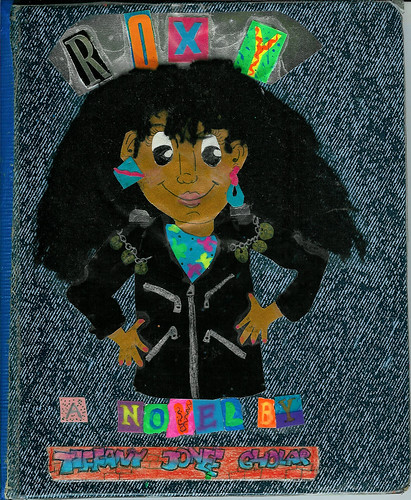
Since November is National Novel Writing Month, I decided that all this month's From the Archives posts will feature illustrations from my novels. At 64 pages, "Roxy" is technically not a novel, but I was 11 when I wrote this and very proud of myself for writing such a long story that I decided to call it a novel. I also illustrated it myself. And I entered it in the Young Author's Contest, but the judges didn't like it. Maybe it's because Roxy joins a gang.
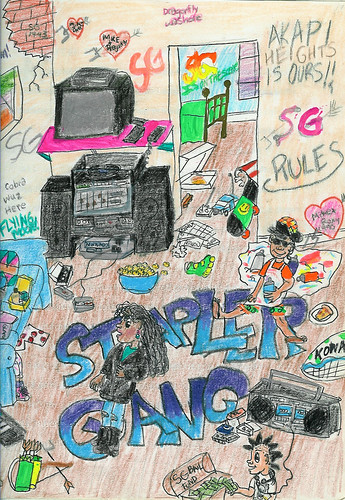
Thursday, October 23, 2008
From the Archives: "Panthea collage," circa 2001
"Panthea" graphite and charcoal on paper 2001
I was working as a guard at the Smart Museum when a very special painting came to us on loan from the Art Institute, Laurent de la Hyre’s “Panthea, Cyrus, and Araspus.” We were instructed to keep an eye on the painting at all times and took turns watching it. At least we were allowed to sit down for that post. Alone in an empty gallery with nothing better to do and forbidden from reading on the job, I made use of the small sketchbook I’d brought with me, and the drawings in my “Panthea Collage” and my “Panthea Gesture Drawings” are the result of those quiet afternoons at work.
Saturday, October 18, 2008
From the archives: "Surreal Love," circa 1993
A drawing within a drawing within a drawing... yes, I was (and still am) an M.C. Escher fan. And speaking of M.C.'s, you can tell I really liked early 90's hip-hop fashion. These kids clearly shopped at Merry Go Round and Chess King. Check out their Doc Martens and Cross Colours!
Sometimes the holes in the notebook paper can be a design element.
Things I like to draw: "marginalized" doodles
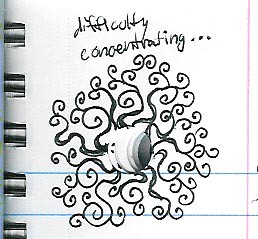 Just like the sitcom babies who always seem to be born when their mothers are in confined spaces with no hope of getting the aid of a trained midwife or obstetrician, my ideas also seem to come at inopportune times. Like when I am in the middle of a class.
Just like the sitcom babies who always seem to be born when their mothers are in confined spaces with no hope of getting the aid of a trained midwife or obstetrician, my ideas also seem to come at inopportune times. Like when I am in the middle of a class. 
This has been true since kindergarten. Unfortunately, it meant that a great many of my early masterpieces were confiscated by the authorities and mailed home to my mother with a note: "Tiffany drew this in class when she was supposed to be reading." Eventually, I learned to conceal this habit by drawing in the margins.
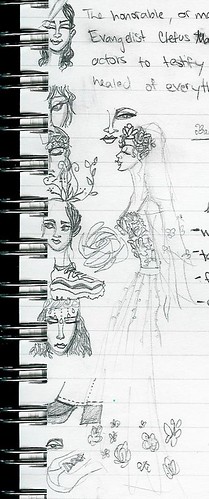 And this one is from a fiction writing class. You can even see some of the story there, a parody of Kafka's "The Nose" featuring a crooked televangelist who experiences an unusual form of divine retribution. I need to finish that story someday. It could be really funny.
And this one is from a fiction writing class. You can even see some of the story there, a parody of Kafka's "The Nose" featuring a crooked televangelist who experiences an unusual form of divine retribution. I need to finish that story someday. It could be really funny.And if you think I only draw while in classes when I lose interest, take a look at these samples from design school:
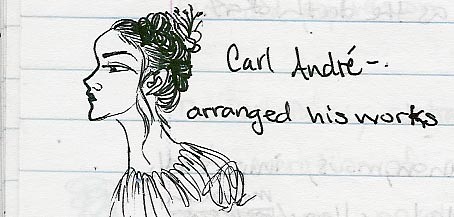 completely unrelated to Carl André
completely unrelated to Carl André 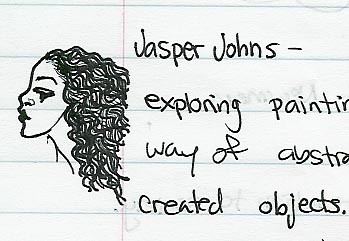 and this has nothing to do with Jasper Johns.
and this has nothing to do with Jasper Johns. And really, that's the reason I save my notebooks. Not for the notes, but for the doodles.
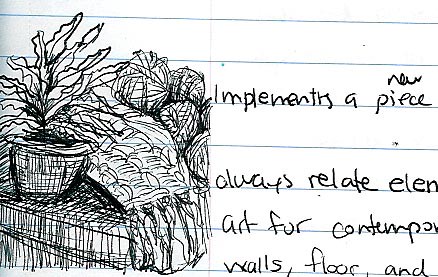 I must confess, I even have done them while taking notes in meetings. I really liked that little tableau in the design center and wanted to capture it.
I must confess, I even have done them while taking notes in meetings. I really liked that little tableau in the design center and wanted to capture it.
Still, I've never been entirely certain of what they all mean. As I wrote on the drawing above,
Women with femme fatale faces glaring up at me from the pages of my notebook— do they want to be characters or subjects of paintings?
Maybe they can be both.









